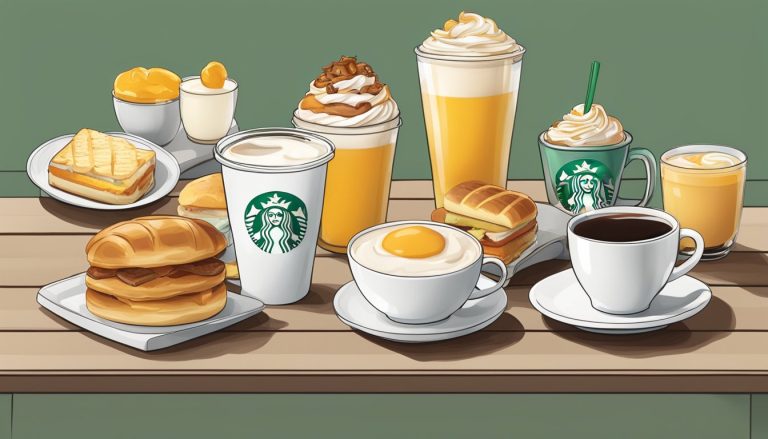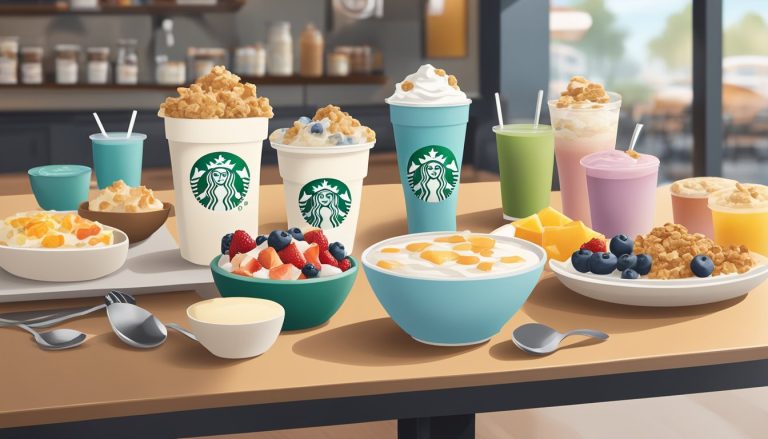Starbucks has revolutionized the coffee industry by positioning itself as an affordable luxury brand. The global coffee giant offers customers a taste of indulgence without breaking the bank. Starbucks’ breakfast menu embodies this concept, providing high-quality morning fare that feels special yet remains accessible to many.
The company’s approach to breakfast mirrors its overall strategy of elevating everyday experiences. From artisanal breakfast sandwiches to premium pastries, Starbucks offers a range of options that cater to different tastes and budgets. These items are often priced slightly higher than fast food alternatives but lower than upscale cafes, striking a balance between quality and affordability.
Starbucks’ success in the breakfast market stems from its ability to create a perception of luxury around simple morning rituals. By offering a curated selection of breakfast items alongside its signature coffee drinks, the company has transformed the act of grabbing a quick bite into a small daily treat. This strategy has helped Starbucks maintain its position as a beloved brand, even as it expands its offerings beyond coffee.
The Evolution of Starbucks

Starbucks transformed from a single coffee bean store to a global phenomenon, revolutionizing coffee culture worldwide. The company’s journey spans decades of innovation, expansion, and strategic leadership.
Founding Vision and History
Starbucks began in 1971 as a single store in Seattle’s Pike Place Market. The original founders – Jerry Baldwin, Zev Siegl, and Gordon Bowker – focused on selling high-quality coffee beans and equipment. They named the company after the first mate in Herman Melville’s Moby-Dick, evoking a sense of seafaring adventure.
In 1981, Howard Schultz joined Starbucks as director of marketing. Inspired by Milan’s espresso bars, Schultz envisioned transforming Starbucks into a coffeehouse chain. When the founders rejected this idea, Schultz left to start his own company, Il Giornale.
In 1987, Schultz acquired Starbucks and merged it with Il Giornale. This marked the beginning of Starbucks’ evolution into the coffeehouse concept we know today.
Global Expansion and Coffee Chain Dominance
Starbucks’ expansion strategy focused on rapid growth and market saturation. The company opened its first international store in Vancouver, Canada, in 1987. By 1996, Starbucks had entered Japan, signaling its push into the Asian market.
Key milestones in Starbucks’ global expansion:
- 1998: Entered the UK market
- 1999: Opened first store in China
- 2000: Reached 3,500 stores globally
- 2020: Over 30,000 stores in 80 countries
Starbucks adapted its offerings to local tastes while maintaining core brand elements. This strategy helped the company become the world’s largest coffeehouse chain.
Leadership and Visionaries
Howard Schultz played a pivotal role in Starbucks’ growth. His vision of creating a “third place” between work and home shaped the company’s culture and customer experience.
Schultz served as CEO from 1987 to 2000, and again from 2008 to 2017. During his tenure, Starbucks experienced explosive growth and became a global brand.
In 2022, Laxman Narasimhan took over as CEO. Narasimhan brings experience from PepsiCo and Reckitt Benckiser, positioning him to lead Starbucks’ next phase of growth.
Strategies for Growth
Starbucks’ growth strategies have evolved over time:
- Store expansion: Rapid opening of new locations to increase market presence.
- Product diversification: Introducing new beverages, food items, and merchandise.
- Digital innovation: Launching mobile ordering and payment systems.
- Partnerships: Collaborating with other brands and entering new distribution channels.
Starbucks has also focused on sustainability initiatives and ethical sourcing practices. These efforts aim to appeal to socially conscious consumers and ensure long-term supply chain stability.
The company continues to innovate, exploring new product lines and digital experiences. As of 2025, Starbucks remains committed to quality, community, and enhancing customer experiences.
Starbucks as a ‘Third Place’
Starbucks revolutionized coffee culture by positioning itself as more than just a cafe. The company embraced sociologist Ray Oldenburg’s concept of the “third place” – a space between home and work where people gather, socialize, and build community.
Concept and Implementation
Starbucks deliberately designed its stores to embody the third place ideal. Comfortable seating, warm lighting, and inviting decor create a welcoming atmosphere. Free Wi-Fi and ample power outlets encourage customers to linger.
Baristas are trained to be friendly and personable, often remembering regular customers’ names and orders. This personal touch fosters a sense of belonging.
The menu offers a range of options beyond coffee, including food and non-caffeinated beverages. This variety caters to different tastes and allows customers to visit at various times of day.
Cultural Impact
Starbucks’ third place strategy significantly influenced urban landscapes and social habits. The ubiquity of Starbucks stores provided consistent, familiar spaces for people to meet, work, or relax in cities worldwide.
The concept spawned numerous imitators, both independent cafes and other chains. This proliferation of coffee shops reshaped downtown areas and suburban strip malls alike.
Starbucks became a cultural touchstone, referenced in movies, TV shows, and everyday conversation. The brand’s success demonstrated the public’s desire for communal spaces in an increasingly digital and isolated world.
Brand Positioning and Marketing
Starbucks has crafted a unique position in the coffee market by blending premium offerings with accessible pricing. Their marketing strategies reinforce this image of attainable luxury.
Defining ‘Affordable Luxury’
Starbucks positions itself as an affordable luxury brand, offering high-quality coffee experiences at prices slightly above average. This strategy appeals to consumers seeking premium products without breaking the bank. The company creates an upscale atmosphere in its stores, using sophisticated decor and personalized service to elevate the coffee-drinking experience.
Starbucks’ menu features both everyday items and special seasonal offerings, allowing customers to indulge occasionally or splurge on premium drinks. By balancing quality and accessibility, Starbucks has successfully carved out a niche between budget coffee shops and high-end cafes.
Advertising and Branding Strategies
Starbucks employs various marketing tactics to reinforce its brand image. The company’s iconic green logo is instantly recognizable worldwide, symbolizing quality and consistency. Starbucks’ advertising often focuses on the craft of coffee-making and the warmth of human connections.
Social media plays a key role in Starbucks’ marketing efforts. The brand engages customers through platforms like Instagram and Twitter, showcasing new products and encouraging user-generated content. Starbucks also utilizes its mobile app for targeted promotions and loyalty rewards, further enhancing the customer experience.
Seasonal campaigns, like the popular Pumpkin Spice Latte promotion, create buzz and drive foot traffic. These limited-time offers align with the brand’s affordable luxury positioning by offering special treats that feel exclusive yet remain within reach for many consumers.
Menu Innovations

Starbucks continually expands its food and beverage offerings to meet customer demands and stay ahead of trends. The company focuses on developing new breakfast items and innovative coffee drinks to maintain its position as a leader in the coffee shop industry.
Breakfast Offerings
Starbucks has significantly expanded its breakfast menu in recent years. The chain now offers a variety of hot breakfast sandwiches, including egg and cheese on English muffins, bagels, and croissants. Healthier options like oatmeal and yogurt parfaits cater to nutrition-conscious customers.
Protein boxes provide convenient grab-and-go meals for busy mornings. These boxes typically contain items like hard-boiled eggs, cheese, fruit, and nuts. Starbucks also introduced sous vide egg bites as a low-carb breakfast option.
Bakery items remain a staple of the breakfast menu. Classics like muffins and scones are joined by trendy offerings such as cake pops and seasonal pastries.
Beverage Development
Starbucks’ beverage innovation extends beyond traditional coffee drinks. The company regularly introduces new flavored lattes and cold brews to keep customers interested. Seasonal offerings, like the Pumpkin Spice Latte, have become cultural phenomena.
In 2023, Starbucks launched its first new pumpkin coffee beverage in years, expanding on the popularity of its fall menu. The chain also debuted a new holiday drink, demonstrating its commitment to menu innovation.
Cold beverages have become a focus area for Starbucks. Nitro cold brew, introduced in select markets, offers a smoother, creamier alternative to traditional iced coffee. The company has also expanded its line of refreshers and tea-based drinks to appeal to non-coffee drinkers.
Economic Aspects

Starbucks’ positioning as an affordable luxury intersects with broader economic trends and the company’s financial performance. Inflation impacts pricing decisions, while revenue growth reflects the brand’s market strength.
Impact of Inflation
Inflation has pushed Starbucks to adjust its pricing strategy. In 2023, the average cost of a medium hot coffee at Starbucks reached $3.07. This price point reflects the company’s efforts to balance affordability with rising input costs.
Starbucks has implemented strategic price increases to maintain profit margins without alienating cost-conscious consumers. The brand’s reputation as an affordable luxury allows it some flexibility in pricing, even as customers face tighter budgets.
Financial Performance and Revenue
Starbucks has demonstrated strong financial performance despite economic challenges. In 2018, the company reported consolidated net revenues of $24.7 billion, a 10% increase from the previous year.
The coffee chain’s global presence contributes significantly to its revenue growth. With over 35,000 stores in 80 countries as of 2023, Starbucks generated nearly $36 billion in revenue.
Starbucks’ ability to maintain its position as an affordable luxury has supported its financial success. The company continues to open new stores, with 604 net new locations added in a single quarter in 2018.
Customer Engagement

Starbucks excels at fostering deep connections with customers through innovative programs and experiences. The company leverages technology and personalization to keep patrons coming back.
Loyalty Programs and Rewards
Starbucks Rewards stands out as a key driver of customer engagement. Members earn “stars” for purchases, redeemable for free drinks and food. The program boasts over 30 million active members globally.
Digital integration enhances the rewards experience. The Starbucks mobile app allows for easy ordering, payment, and star tracking. Members receive personalized offers based on their preferences and purchase history.
Tiered membership levels provide additional perks. Gold members enjoy free refills and exclusive promotions. This structure incentivizes increased spending and visit frequency.
Customer Experience Transformation
Starbucks continually evolves its in-store experience to meet changing customer needs. Mobile ordering and payment options reduce wait times and enhance convenience.
Baristas are trained to provide personalized service. They’re encouraged to learn customer names and remember regular orders. This creates a sense of community and belonging.
Store designs incorporate local elements to reflect each neighborhood’s character. Comfortable seating areas invite customers to linger, reinforcing Starbucks’ “third place” concept between home and work.
Digital menu boards and customization options cater to individual tastes. Seasonal offerings and limited-time promotions keep the menu fresh and exciting for repeat visitors.
Competitive Analysis

Starbucks’ breakfast offerings face competition from both fast-food chains and high-end cafes. The company’s positioning as an affordable luxury brand influences consumer perceptions of quality and value.
Comparison with Fast-Food Chains
Starbucks competes directly with fast-food giants like McDonald’s in the breakfast market. McDonald’s offers lower-priced options, aiming for value-conscious customers. Starbucks, however, focuses on premium ingredients and a more upscale ambiance.
The price difference is significant. A Starbucks breakfast sandwich typically costs $3-$5, while McDonald’s offers similar items for $1-$3. Despite higher prices, Starbucks maintains strong sales due to perceived quality and brand loyalty.
Starbucks’ coffee quality is generally regarded as superior to fast-food alternatives. This perception helps justify the price premium and attracts customers willing to pay more for a better product.
Quality and Prestige Perception
Starbucks has successfully positioned itself as an affordable luxury brand. This strategy allows them to charge higher prices while maintaining a broad customer base.
The company’s emphasis on high-quality ingredients and ethical sourcing contributes to its premium image. Starbucks uses arabica beans, while many competitors use cheaper robusta varieties.
Store design plays a crucial role in Starbucks’ prestige perception. Comfortable seating, free Wi-Fi, and a welcoming atmosphere create a “third place” between home and work. This environment justifies higher prices compared to grab-and-go competitors.
Starbucks’ customization options also add to its perceived value. Customers can modify drinks to their exact preferences, a service less common in fast-food chains.




